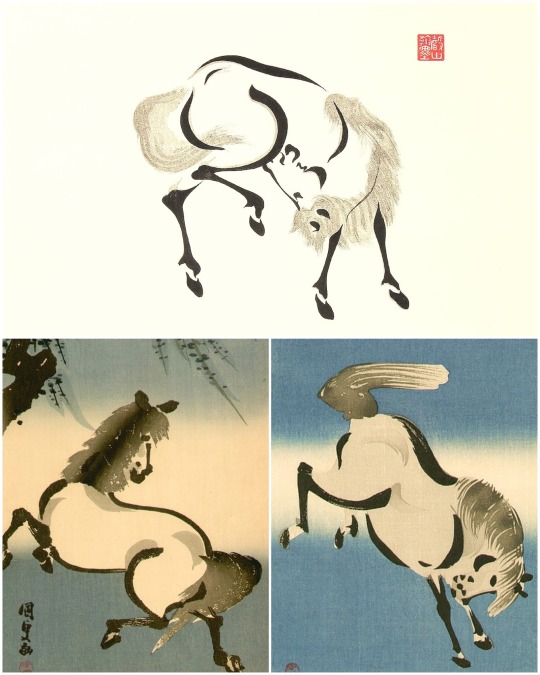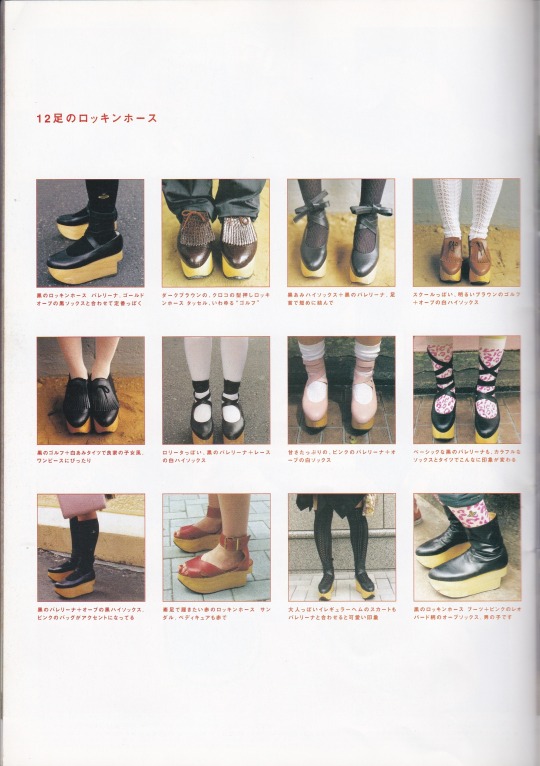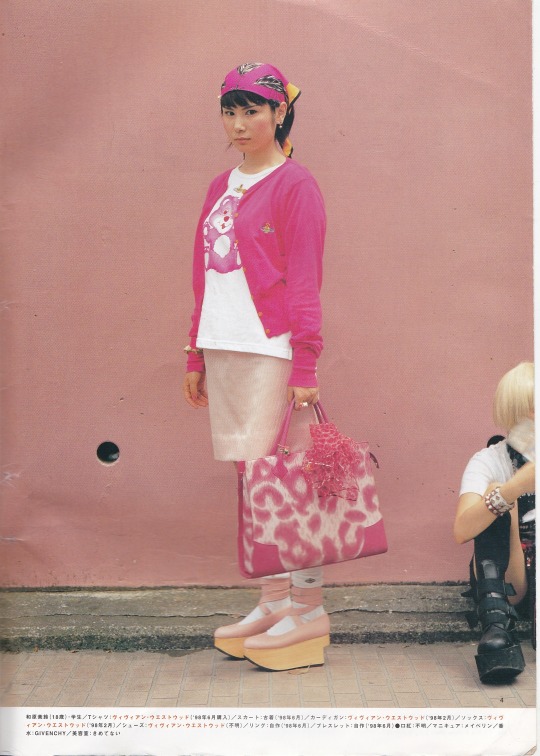#japanese horse
Explore tagged Tumblr posts
Text
Mysterious Extinct Japanese Cow-Horse

"Wushi-uma" taken from Wikimedia, from 1934.
I'm currently reading Year of the Wild Boar, a memoir by Helen Mears about her time spent in Japan in the mid-1930s. Without context or explanation, she quotes several accounts of an isolated, unique horse breed called the "Ushi-uma". It lived only on Tanegashima Island and was said to closely resemble a cow (ushi-uma means "cow horse"), primarily for having no mane or hair on its tail. According to Wikipedia, the breed was extinct by 1950.

Ushi-uma netsuke taken from zacke.at.
Has anyone ever heard of this beast? Is this a hoax? It doesn't look inordinately cowlike to me -- it has the heavy forehand and less developed hindquarters you see in Przewalski's horses. But the hair thing is weird. Does anyone on horseblr have ideas about the mane and tail?
Apparently it had government protection but was still extinct within a matter of decades. I wonder if WW2 played a part.
#horse#ushiuma#ushi-uma#cow horse#japanese horse#extinct horse#extinction#horse breed#old photo#year of the wild boar#netsuke#model horse
7 notes
·
View notes
Text







japanese racehorse blinders 🍀
#equestrian#equidae#equine#equines#horse#horse posting#horseblr#horses#racehorse#racehorses#horse racing#horse races#off to the races#thoroughbred#ottb#equestrian blog#equestrianlife#horse tack#japan#japanese#unique fashion
571 notes
·
View notes
Text


Aoyama Seizan, Horses, 1930s
#Aoyama Seizan#horses#woodcut#japanese prints#woodblock print#equestrian#horseback riding#asian art#aesthetic#asian aesthetic#japanese aesthetic#modern art#art history#aesthetictumblr#tumblraesthetic#tumblrpic#tumblrpictures#tumblr art#tumblrstyle#japanese art#beautiful animals#wildlife#nature#beautiful horse
4K notes
·
View notes
Text


#aesthetic#art#fashion#photography#coquette#grunge#pale#vintage#dollette#angelcore#horse#horse riding#japanese#kawaii#style#outfit#gothic#gaslight gatekeep girlboss#girl blogger#grungecore#soft grunge#dark core#dark#interior#main character#tumblr girl#y2k#office siren#cybergoth#cybercore
424 notes
·
View notes
Text

SAMPLING Volume 1 September 1998 A selection of 12 pairs of Vivienne Westwood Rocking Horse Shoes
#Vivienne Westwood#Rocking Horse Shoes#RHS#1998#90s fashion#90s jfashion#90s jpunk#90s punk#Japanese Street Fashion#jfashion#VW#Old School Lolita#SAMPLING
5K notes
·
View notes
Text

Sun Arrow Potte Pony
#horse#horseblr#horses#plushy#plushies#toys#equine#plush#stuffy#stuffies#pony#ponies#pinto horse#japanese merch#plushblr#plushcore#soft toy#soft toys
96 notes
·
View notes
Text



Plant of the Day
Thursday 6 February 2025
In the small arboretum of the Cruickshank Botanic Garden, Aberdeen, Scotland, was this young specimen of Aesculus turbinata (Japanese horse chestnut). This will become a large broad-crowned, deciduous tree with flowers that are creamy-white with a red spot produced in upright panicles (known as candles). The fruit will be roughly pear-shaped, with few or no spines on the case. But in the winter light it was the bark that attracted attention.
Jill Raggett
#Aesculus#Japanese horse chestnut#tree#deciduous#bark#habit#plants#horticulture#gardens#garden#aberdeen#Cruickshank Botanic Garden#arboretum#sticky buds
58 notes
·
View notes
Text

Nakayama Tadashi (Japanese,1927-2014) - The Dancing Horse
180 notes
·
View notes
Text

'Spring Warmth' (1897) by Kogetsu Saigō (1873–1912).
The University Art Museum, Tokyo University of the Arts
artsandculture.google.com - Wikimedia
114 notes
·
View notes
Text

Utagawa Kunisada - Early Summer Rain (Samidare no kei), color woodblock print, c. 1832.
43 notes
·
View notes
Text
Google Translate ML-misuse-induced "No Wooden Horses" error of the day: it now frequently translates "本日" ("honjitsu"), meaning "this day" as "Sunday" - or possibly as the specific day of the week upon which the text is run through the translator! Will have to retry after midnight.
This is a particularly-dangerous fuckup: honjitsu and the days of the week are, obviously, extremely-common words. GTranslate's insistence on translating "wooden horse" as "horse" (because most horses are not made of wood), or refusal to translate rude terms like "temee" at all (because they're rude and don't appear in press releases), cannot compare.
Even translating "oneesan" as "gay man" isn't this big a problem: in nearly every situation in which that error occurs, it's going to be obvious to the reader that it is an error. "Honjitsu" intermittently turning into a specific day of the week is going to slip by without notice. That's a big-deal problem. Lawsuit shit.
31 notes
·
View notes
Text
More for #ILoveHorsesDay ❤️🐴:


Horses, a New Publication (Shimpan uma zukushi)
Color woodblock prints
c.1847-8 by Utagawa Hiroshige II (Japan, 1826–1869), 377x257mm
1874 by Utagawa Kunisada III (Japan, 1848–1920), 337x225mm
Legion of Honor Museum 1963.30.1472, 1963.30.5519
#animals in art#animal holiday#19th century art#Legion of Honor Museum#Japanese art#East Asian art#Asian art#horse#horses#I Love Horses Day#domesticated animals#print#woodblock print#Utagawa Hiroshige II#Utagawa Kunisada II#ukiyoe
75 notes
·
View notes
Text










Kusasenrigahama (草千里ヶ浜)
This was an unforgettable stop, though I’ll admit, it felt like I’d stumbled into the middle of a frosty tundra. The freezing temperatures made the ground icy and treacherous, with each step feeling like a test of balance. The dry, biting air didn’t help much either—my face felt like it was being sandblasted by winter itself. Despite the chill, the scenery was absolutely breathtaking. This expansive grassy plain, located in the Aso Caldera, stretches out against the dramatic backdrop of Mount Eboshi, creating a landscape that feels like something out of a storybook.
What made the experience even more magical were the horses standing proudly across the plains, seemingly unfazed by the cold. Kusasenrigahama has a long history as a grazing area for livestock, with horses and cattle calling it home for centuries. These magnificent creatures, standing tall against the rugged volcanic backdrop, seemed like guardians of the land, embodying the area’s enduring spirit. Even with the icy conditions, their stillness in such a harsh environment added to the serene beauty of the place—an enchanting contrast to the bustling cities of Japan. It was a moment of pure calm, where time seemed to slow and nature’s majesty took center stage.
—Emmy
#japan#fukuoka#japan travel#travel#japan photos#日本#nature#volcano#landscape#snow#winter#horses#mountain#Kumamoto#Japanese#photography
31 notes
·
View notes
Text


SAMPLING Volume 1 September 1998
2K notes
·
View notes
Text

Aoyama Seizan
Horse
ca. 1930s
#aoyama seizan#horses#woodcut#japanese prints#woodblock print#animals in art#beautiful horse#beautiful animals#japanese artist#modern art#art history#aesthetictumblr#tumblraesthetic#tumblrpic#tumblrpictures#tumblr art#japanese art#tumblrstyle#equestrian#horseback riding#wildlife#nature
369 notes
·
View notes
Text
JRA Animatronic Thoroughbreds [And One Pony]




Hello, I'm Mod Horse and for my first post this year, I'll be sharing these AMAZING animatronic horses created to promote the JRA [Japan Racing Association].
The white thoroughbred and his pony friend were displayed at the Shiodome in Tokyo during 2019, while the chestnut was/is displayed at the Equine Cultural Affairs Foundation Of Japan. The black horse and the bay horse featured models astride them [I believe the white one did as well, though I'm having difficulty finding images] and were featured at Tokyo Station, evidently. The description of this video featuring the black and bay states they had "warm breath and twitching skin" included, which would be a hell of a feature!
I've linked the videos featuring these gorgeous creations in motion in the paragraph above, so definitely check them out! They seem to have been reused and refeatured here in there across the time between their rollout and now, so there's quite a few different photos of them out there.
They're incredibly stunning and they are truly lifelike, a difficult task on anything less than a feature film budget. Or maybe anything less than the JRA's special events publicity fund! They've funded some truly amazing collaborations and events, one of which I'll be sharing sooner or later, work schedule allowing....
Mod Horse
#horses#jra#horse animatronics#publicity animatronics#advertising animatronics#japanese animatronics#animatronics#japanese racing association#pony animatronic#pony animatronics#mod horse goes neigh
33 notes
·
View notes